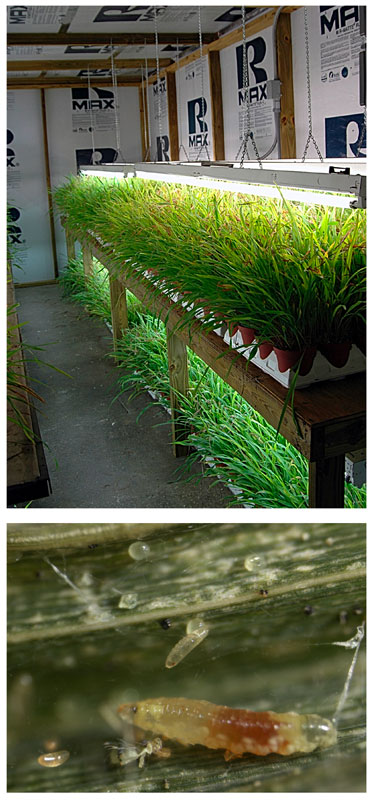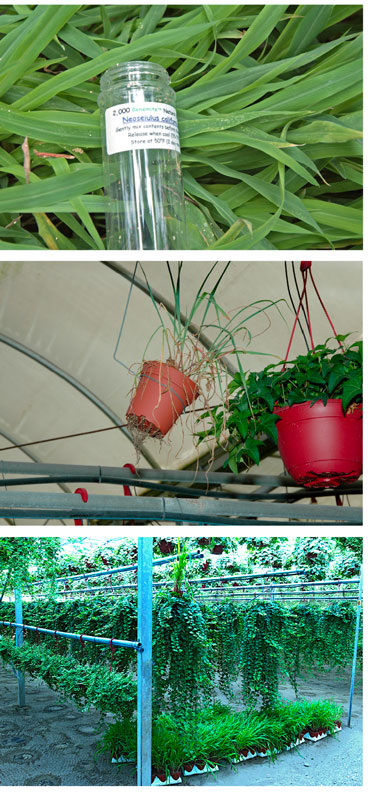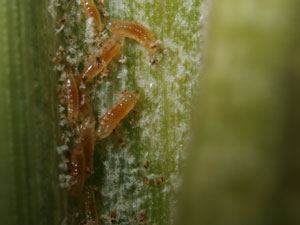4/1/2023
Using Banker Plants to Control Mites
Lance S. Osborne, Muhammad Z. Ahmed & Cindy McKenzie

Because mite infestations and pesticide resistance development are constant threats in many ornamental crops, developing efficient biological control programs and, eventually, a banker plant system seemed like a logical first step many years ago. By protecting crops from pest infestations, the banker plant system reduces the need for pesticide applications.
We first developed a banker system to make the use of predatory mites in ornamental foliage plant production more dependable and economical. The other banker plant systems were developed because the mite system proved to be so useful.
Initially, we were working with smaller growers to demonstrate the utility of biological control of mites, and specifically, the use of banker plants to aid in the adoption of predatory mite releases for use in ornamental crops. Smaller growers often stated that the cost was a limiting factor in using commercially available predators, and secondly, dispersing the predators by spreading the mites on corn grit or vermiculite reinforced this perception. So much of the carrier wasn’t staying on the plants where the predators were needed, but falling on the floor.
Pictured: A section of a small rearing room showing corn infested with the Banks grass mites. These plants will be moved on carts to an area with the nursery where they’ll be infested with commercially obtained predatory mites.
Midge larvae, Feltiella acarisuga, feeding spider mites. The adults of these predators fly so the banker plants can be placed anywhere in the greenhouse—they don’t have to be in contact with the crop plants.
By using banker plants, we were able to show that predatory mites can be cost effective and easily integrated into a grower’s existing production system. The use of banker plants allows for a more targeted and efficient dispersal of predatory mites, enabling growers to reduce the cost of purchasing and continuously releasing predatory mites and the amount of manual labor required to spread the predators while still achieving the desired level of pest control.
As growers used the system, it evolved into a teaching tool, a method to determine the quality of purchased predators, and a tool to educate students about agriculture and biological control.
The system
The system required a plant that we could grow from cheap and readily available seed. We chose corn. We purchased corn that’s used for feeding animals because it hasn’t been treated with pesticides. We currently use any corn, even if treated, because we’ve not had any negative impacts from the treatments on rearing prey mites or predators.
The prey mite we chose to use was the Banks grass mite (BGM), Oligonychus pratensis (Banks), because the work done in Texas demonstrated that it could be controlled in the field by commercially available predatory mites. This system was also attractive because the BGM, like the twospotted spider mite (TSSM), can be found in many states, thus making it a system that much of the ornamental industry could use. It should be noted that this mite will try to feed on some plants, but not establish. We don’t recommend its use in a banker plant that’s placed in close proximity to palms or Ficus lyrata (fiddle leaf fig).
 We test each banker plant system on a few isolated plants from the crop we’re trying to protect from spider mites before widescale use. For sensitive plants, we place the infested bankers far from the crop and only put them closer once most of the alternate prey have been consumed, or we use a different system we’ve developed for palms.
We test each banker plant system on a few isolated plants from the crop we’re trying to protect from spider mites before widescale use. For sensitive plants, we place the infested bankers far from the crop and only put them closer once most of the alternate prey have been consumed, or we use a different system we’ve developed for palms.
Pictured: Banker plants being infested with commercially obtained predators.
A banker plant infested with the Banks grass mites and predatory mites.
Banker plants waiting to be distributed with ivy stock plants.
The corn/BGM system can be used for rearing Stethorus spp., Feltiella acarisuga (predatory gall midge), Scolothrips sexmaculatus (six-spotted thrips), Neoseiulus californicus, Neoseiulus (= Amblyseius) fallacis or Phytoseiulus persimilis.
The trials
Banker plant systems were used at one of Florida’s premier and largest nurseries (now permanently closed). Their system was used to increase the number of N. californicus available for release. The grower planted corn weekly. Once the plants reach a height of about 12 in., they were infested with the BGM. This mite doesn’t feed on ivy, croton, hibiscus, dieffenbachia or any of the crops grown in this particular nursery.
The grower received a shipment of N. californicus or P. persimilis every week. These predators were then released, with some of the shipments being held back to be put on the invested corn plants. These “banker” plants were held for a period of time before they were placed into the crop. This particular company mainly concentrated on using the banker plants in their stock ivy facility. These greenhouses had high roofs and the plants were hung in such a fashion that the grower had to stand on stilts to spray the vines and crowns of the plants. They did this 52 weeks out of the year. This resulted in the development of pesticide-resistant populations and infested cuttings that made their way into the production and finishing houses.
The banker plants were randomly hung throughout the crop and the predators would move from them to the ivy stock plants in search of spider mites. The plants were occasionally moved to places in the ivy to allow better distribution of the predators. Most of the time, the plants didn’t have emitters placed in the pots because the grower wanted the plants to decline and force the predators to move into the ivy.
The grower reported that he only treated the stock plants for mites once in an entire year. He did report that the cuttings were less infested than the cuttings he’d previously obtained using miticides. The grower did admit that the cuttings weren’t 100% clean, but the mites on the cuttings hadn’t been exposed to pesticides for at least 51 weeks, thus reducing the potential for them to be highly tolerant to miticides. Cuttings were grown, once out to the mist, using traditional methods.
Make your own banker plant system
To produce the banker plant system, you need three separate units. First, you need to produce clean corn plants. The grower that used banker plants to protect his ivy built a series of insulated rooms with heating, cooling, lighting and benches. In the first room, he would seed the 4-in. pots with corn. In the next room, he would inoculate corn that had grown to a height of 8 to 12 in. with BGM. The final room was used initially to inoculate his prey-infested plants with predators.
After experiencing major issues with the predators getting into the rooms with the prey mites, he would place the mite-infested plants in the greenhouse where he intended to use them and inoculated the plants on the carts with the predators he purchased. He would maintain those plants on the carts for about a week after releasing the predators on them. This allowed them to become established and begin reproducing prior to being placed in the crop. During this process as each set of banker plants was used, the grower would clean the growing rooms and allow empty rooms to sit without plants for at least a week without any plant material in them. Once he quit rearing predators in one of the rooms, he always had a couple rooms that would be empty prior to starting a new crop of corn banker plants.
 Pictured: Midge larvae feeding on Banks grass mites.
Pictured: Midge larvae feeding on Banks grass mites.
The same idea can be used to simply rear predatory mites on a tabletop. The corn is grown in a clean greenhouse. Leaves are harvested at least once a week and placed in a plastic-rearing container in our lab. In this container, there are older leaves infested with BGM. The leaves are simply added to the container to feed the BGM. Each day, prior to adding food to keep the BGM colony going, remove half of the leaves and take them to a similar rearing container that has predatory mites. These leaves are simply added to the container to feed the predators and used as needed to manage hotspots of spider mites or broad mites.
One highly important lesson learned by both growers and us was that this system proved to be a critical tool for evaluating the quality of commercially obtained predators. Over the years, many growers have complained that the predators they purchased didn’t consistently manage the spider mites as expected. They’d experienced successful control, but noticed sometimes it appeared like the thousands of predators they thought they released didn’t do anything. Often, the growers were told that the predators must have been exposed to pesticide residues on the plants to which they were applied.
The banker plant system does a number of things:
1. It allows the grower the ability to detect problems with the health and quality of the purchased predators.
2. It ensures a continuous supply that enables the grower to treat hot spots as needed during crop production.
3. Because the banker plants are mini-rearing units in the crop, the number of predatory mites in the system greatly increases on the banker plants, making the use of predatory mites more economical.
4. It’s attractive to additional “wild” natural enemies.
5. Increases the efficacy of the predators. GT
Funding for this research was provided by the USDA-ARS Floriculture and Nursery Research Initiative.
Lance S. Osborne is with the university of Florida, IFAS and Mid-Florida Research & Education Center. Cindy McKenzie and Muhammad Z. Ahmed are with the USDA-ARS Horticultural Research Laboratory in Fort Pierce, Florida.